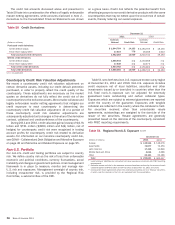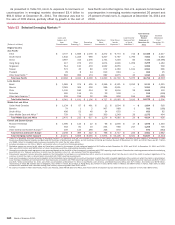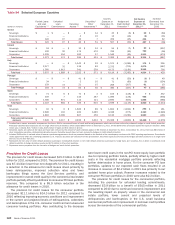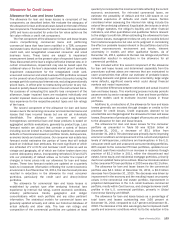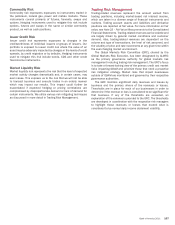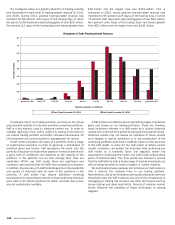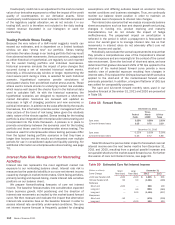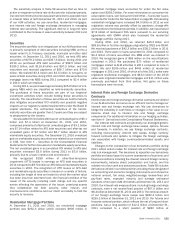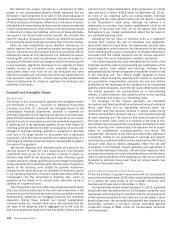Bank of America 2011 Annual Report Download - page 110
Download and view the complete annual report
Please find page 110 of the 2011 Bank of America annual report below. You can navigate through the pages in the report by either clicking on the pages listed below, or by using the keyword search tool below to find specific information within the annual report.
108 Bank of America 2011
The histogram below is a graphic depiction of trading volatility
and illustrates the daily level of trading-related revenue for 2011
and 2010. During 2011, positive trading-related revenue was
recorded for 86 percent (214 days) of the trading days of which
66 percent (165 days) were daily trading gains of over $25 million,
five percent (12 days) of the trading days had losses greater than
$25 million and the largest loss was $119 million. This is
compared to 2010, where positive trading-related revenue was
recorded for 90 percent (225 days) of the trading days of which
75 percent (187 days) were daily trading gains of over $25 million,
four percent (nine days) of the trading days had losses greater
than $25 million and the largest loss was $102 million.
To evaluate risk in our trading activities, we focus on the actual
and potential volatility of individual positions as well as portfolios.
VaR is a key statistic used to measure market risk. In order to
manage day-to-day risks, VaR is subject to trading limits both for
our overall trading portfolio and within individual businesses. All
limit excesses are communicated to management for review.
A VaR model simulates the value of a portfolio under a range
of hypothetical scenarios in order to generate a distribution of
potential gains and losses. VaR represents the worst loss the
portfolio is expected to experience based on historical trends with
a given level of confidence and depends on the volatility of the
positions in the portfolio and on how strongly their risks are
correlated. Within any VaR model, there are significant and
numerous assumptions that will differ from company to company.
In addition, the accuracy of a VaR model depends on the availability
and quality of historical data for each of the positions in the
portfolio. A VaR model may require additional modeling
assumptions for new products that do not have extensive historical
price data or for illiquid positions for which accurate daily prices
are not consistently available.
A VaR model is an effective tool in estimating ranges of potential
gains and losses on our trading portfolios. There are, however,
many limitations inherent in a VaR model as it utilizes historical
results over a defined time period to estimate future performance.
Historical results may not always be indicative of future results
and changes in market conditions or in the composition of the
underlying portfolio could have a material impact on the accuracy
of the VaR model. In order for the VaR model to reflect current
market conditions, we update the historical data underlying our
VaR model on a bi-weekly basis and regularly review the
assumptions underlying the model. Our VaR model utilizes three
years of historical data. This time period was chosen to ensure
that the VaR reflects both a broad range of market movements as
well as being sensitive to recent changes in market volatility.
We continually review, evaluate and enhance our VaR model so
that it reflects the material risks in our trading portfolio.
Nevertheless, due to the limitations previously discussed, we have
historically used the VaR model as only one of the components in
managing our trading risk and also use other techniques such as
stress testing and desk level limits. Periods of extreme market
stress influence the reliability of these techniques to varying
degrees.
0
10
20
30
40
50
60
70
80
greater than -100 -100 to -75 -75 to -50 -50 to -25 -25 to 0 0 to 25 25 to 50 50 to 75 75 to 100 greater than 100
Number of Days
Revenue (dollars in millions)
Histogram of Daily Trading-related Revenue
Year Ended December 31, 2011 Year Ended December 31, 2010


